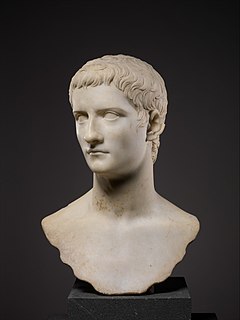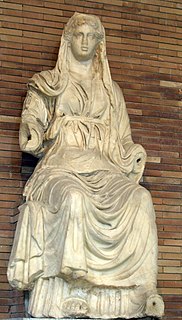Related Research Articles

Gaius Caesar Augustus Germanicus, better known by his nickname Caligula, was the third Roman emperor, ruling from 37 to 41. The son of the popular Roman general Germanicus and Augustus' granddaughter Agrippina the Elder, Caligula was born into the first ruling family of the Roman Empire, conventionally known as the Julio-Claudian dynasty. Germanicus' uncle and adoptive father, Tiberius, succeeded Augustus as emperor of Rome in AD 14.

The Ides of March is the 74th day in the Roman calendar, corresponding to 15 March. It was marked by several religious observances and was notable for the Romans as a deadline for settling debts. In 44 BC, it became notorious as the date of the assassination of Julius Caesar, which made the Ides of March a turning point in Roman history.

Cybele is an Anatolian mother goddess; she may have a possible forerunner in the earliest neolithic at Çatalhöyük, where statues of plump women, sometimes sitting, have been found in excavations. Phrygia's only known goddess, she was probably its national deity. Greek colonists in Asia Minor adopted and adapted her Phrygian cult and spread it to mainland Greece and to the more distant western Greek colonies around the 6th century BC.

A gallus was a eunuch priest of the Phrygian goddess Cybele and her consort Attis, whose worship was incorporated into the state religious practices of ancient Rome.

Marcus Agrippa Postumus, later named Agrippa Julius Caesar, was a Roman nobleman who was the youngest son of Marcus Vipsanius Agrippa and Julia the Elder, the daughter and only biological child of the Roman Emperor Augustus. Augustus initially considered Postumus as a potential successor, and formally adopted him as his heir, but banished him from Rome in AD 6 on account of his ferocia. In effect, this action cancelled his adoption, and virtually assured Tiberius' emplacement as Augustus' sole heir. Postumus was ultimately executed by his own guards shortly after Augustus' death in AD 14.

In ancient Roman religion, the Cerealia was the major festival celebrated for the grain goddess Ceres. It was held for seven days from mid- to late April. Various agricultural festivals were held in the "last half of April". The Cerealia celebrated the harvest, and may have begun on the 19th. Surviving descriptions of Rome's city festival of Ceres are presumably urban versions of an originally rustic, agricultural festival. In his treatise on agriculture, Cato the elder recommends that farmers sacrifice a sow to Ceres, before the harvest.
Vatican Hill is a hill located across the Tiber river from the traditional seven hills of Rome, that also gave the name of Vatican City. It is the location of St. Peter's Basilica.

Lucius Caesar was a grandson of Augustus, the first Roman emperor. The son of Marcus Vipsanius Agrippa and Julia the Elder, Augustus' only daughter, Lucius was adopted by his grandfather along with his older brother, Gaius Caesar. As the emperor's adopted sons and joint-heirs to the Roman Empire, Lucius and Gaius had promising political and military careers. However, Lucius died of a sudden illness on 20 August AD 2, in Massilia, Gaul, while traveling to meet the Roman army in Hispania. His brother Gaius also died at a relatively young age on 21 February, AD 4. The untimely loss of both heirs compelled Augustus to redraw the line of succession by adopting Lucius' younger brother, Agrippa Postumus as well as his stepson, Tiberius on 26 June AD 4.
A number of temples to Cybele in Rome have been identified. Originally an Anatolian mother goddess, the cult of Cybele was formally brought to Rome during the Second Punic War after a consultation with the Sibylline Books.

The Temple of Cybele or Temple of Magna Mater was Rome's first and most important temple to the Magna Mater, who was known to the Greeks as Cybele. It was built to house a particular image or form of the goddess, a meteoric stone brought from Greek Asia Minor to Rome in 204 BC at the behest of an oracle and temporarily housed in the goddess of Victory's Palatine temple. The new temple was dedicated on 11 April 191 BC, and Magna Mater's first Megalesia festival was held on the temple's proscenium.
The Megalesia, Megalensia, or Megalenses Ludi, was a festival celebrated in Ancient Rome from April 4 to April 10, in honour of Cybele, known to Romans as Magna Mater. The name of the festival derives from Greek Megale (μϵγάλη), meaning "Great". Ludi were the games or entertainments associated with religious festivals.
The gens Caesonia was a plebeian family of ancient Rome. They first appear in history during the late Republic, remaining on the periphery of the Roman aristocracy until the time of Nero. Roman empress Milonia Caesonia, the last wife of the emperor Caligula was presumably descended from the Caesonii, as she bore their nomen. Another family of Caesonii attained the consulship several times beginning in the late second century; it is not clear how or whether they were related to the earlier Caesonii.
Gaius Calvisius Sabinus was a Roman Senator, who was consul in AD 26 as the colleague of Gnaeus Cornelius Lentulus Gaetulicus. During the reign of Caligula, he was accused of conspiring against the emperor, and took his own life rather than submit to a trial.

Fortuna Huiusce Diei was an aspect of the goddess Fortuna, known primarily for her temple in the Area Sacra di Largo Argentina at Rome. Cicero lists her among the deities who should be cultivated in his ideal state, because "she empowers each day". She thus embodies an important aspect of time as it figures in Roman religion: every day of the year had a distinct and potent nature, which the public priests were responsible for knowing and aligning the community with by means of the religious calendar.

Martius or mensis Martius ("March") was the first month of the ancient Roman year until possibly as late as 153 BC. After that time, it was the third month, following Februarius (February) and preceding Aprilis (April). Martius was one of the few Roman months named for a deity, Mars, who was regarded as an ancestor of the Roman people through his sons Romulus and Remus.

In the Roman Empire, Rosalia or Rosaria was a festival of roses celebrated on various dates, primarily in May, but scattered through mid-July. The observance is sometimes called a rosatio ("rose-adornment") or the dies rosationis, "day of rose-adornment," and could be celebrated also with violets (violatio, an adorning with violets, also dies violae or dies violationis, "day of the violet[-adornment]"). As a commemoration of the dead, the rosatio developed from the custom of placing flowers at burial sites. It was among the extensive private religious practices by means of which the Romans cared for their dead, reflecting the value placed on tradition (mos maiorum, "the way of the ancestors"), family lineage, and memorials ranging from simple inscriptions to grand public works. Several dates on the Roman calendar were set aside as public holidays or memorial days devoted to the dead.

The Porta Carmentalis was a double gate in the Servian Walls of ancient Rome. It was named for a nearby shrine to the goddess or nymph Carmenta, whose importance in early Roman religion is also indicated by the assignment of one of the fifteen flamines to her cult, and by the archaic festival in her honor, the Carmentalia. The shrine was to the right as one exited the gate.

The Temple of Isis and Serapis was a double temple in Rome dedicated to the Egyptian deities Isis and Serapis on the Campus Martius, directly to the east of the Saepta Julia. The temple to Isis, the Iseum Campense, stood across a plaza from the Serapeum dedicated to Serapis. The remains of the Temple of Serapis now lie under the church of Santo Stefano del Cacco, and the Temple of Isis lay north of it, just east of Santa Maria sopra Minerva. Both temples were made up of a combination of Egyptian and Hellenistic architectural styles. Much of the artwork decorating the temples used motifs evoking Egypt, and they contained several genuinely Egyptian objects, such as couples of obelisks in red or pink granite from Syene.

The Almone is a small river of the Ager Romanus, a few miles south of the city of Rome. Today the river is polluted and is channelled to a sewage treatment plant and no longer reaches its natural confluence with the Tiber.
The gens Milonia was an obscure plebeian family at ancient Rome. The first member of this gens mentioned in history was Gaius Milonius, a Roman senator, and one of Cinna's allies. The empress Milonia Caesonia was presumably descended from this family. A few Milonii are known from inscriptions.
References
- ↑ Lawrence Richardson, A New Topographical Dictionary of Ancient Rome (Johns Hopkins University Press, 1992), p. 180; Antony A. Barrett, Caligula: The Corruption of Power (Taylor & Francis, 1989, 2001), p. 303, citing Filippo Coarelli and others.
- ↑ Cassius Dio 59.14.6–7.
- ↑ Richardson, New Topographical Dictionary, p. 180.
- ↑ Michele Renee Salzman, On Roman Time: The Codex Calendar of 354 and the Rhythms of Urban Life in Late Antiquity (University of California Press, 1990), pp. 167, 169.
- ↑ CIL 6.2028e; Suetonius, Caligula 14.1, as cited by Richardson, New Topographical Dictionary, p. 180.
- ↑ Duncan Fishwick, "The Cannophori and the March Festival of Magna Mater," Transactions of the American Philological Association 97 (1966), pp. 193–194.